 If your fabric is sheer, you may want to underline your Pendrell Blouse. I know a lot of you are already planning to underline your blouses for the Sew-Along. You may wonder, what’s the difference between lining and underlining?
If your fabric is sheer, you may want to underline your Pendrell Blouse. I know a lot of you are already planning to underline your blouses for the Sew-Along. You may wonder, what’s the difference between lining and underlining?
Underlining is different from lining, in that it’s sewn to the main fabric as a backing. Lining is sewn to the main fabric as a separate layer.
Once underlining is attached to the main fabric, it’s treated as a single layer of fabric! Lining is constructed separately, and then attached later on.
Lining is often used in home sewing patterns, with separate pattern pieces provided. Underlining is rarely called for in modern sewing patterns, it’s something us sewists add in ourselves.
Now that you know the difference between underlining and lining, follow along as we discuss how to underline the Pendrell Blouse!
Read the rest of the Sew-Along posts here!
- Pendrell Sew-Along #1: Prewashing your Fabric
- Pendrell Sew-Along #2: Measuring and Choosing Your Size
- Pendrell Sew-Along #3: Shortening the Blouse Length
- Pendrell Sew-Along #4: Altering The Hip and Waist
- Pendrell Sew-Along #5: Princess-Seam FBA (Full Bust Adjustment)
- Pendrell Sew-Along #6: Cutting Your Fabric
- Pendrell Sew-Along #7: Bonus Post! Cutting Scalloped-Edge Lace
For my demonstration, I’ll be cutting the Pendrell Blouse in a sheer, silk chiffon. I’m going to use a cream rayon lining as the underlining and I’m making View A, the draped sleeve version.

Choosing an Underlining:
The right underlining depends on the main fabric you’re using! That being said, there is more than one ‘right’ fabric to use for underlining. Underlining can change the feel of your main fabric, which can be a good thing or a bad thing. Here are some examples of main fabrics that might require underlining. Feel free to jump in with your own suggestions as well!
Cotton voile or lawn: Likely, you’re underlining here to prevent sheerness. In that case, I’d suggest a lightweight solid-coloured cotton voile, or cotton batiste. Something of similar weight or slightly lighter would work well!
Silk or polyester chiffon: Same here, you’re probably concerned about sheerness and perhaps want to thicken the blouse fabric slightly! That’s why I’m underlining my silk chiffon – it’s way too sheer to wear over just a bra, and I’d like to wear it without a camisole underneath. (I don’t like the feel of multiple bra strap layers!)If you look at the photo above, see how much brighter the left side is, with the cream underlining?
You could use a silk or polyester charmeuse or lining fabrics to give the fabric the same hand and drape. Or, if you wanted more structure to your blouse, you could use cotton batiste or lawn as an underlining. The blouse would look stiffer and slightly more structured, but it might be easier to sew and work with.
Some decisions to make before cutting:
- Neck and Armhole Binding: which fabric is better suited for binding? In my case, I’m going to use the rayon lining fabric, as I’m imagining it to be more stable than the sheer chiffon. This all depends on your fabric choices! If you’re making the main fabric lace, like in the Cutting Scalloped-Edge Lace post, then you’ll also want to use your underlining fabric for the binding pieces. However, if you’re using something lovely like a cotton voile, and are underlining just for modesty, then perhaps you might want to use the cotton voile for binding pieces as well. (Want my opinion? Tell us what fabrics you’re using in the comments, and I’ll tell you what I think!)
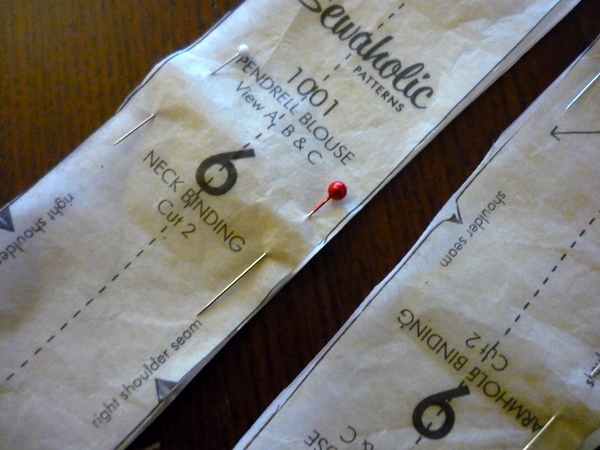
- Sleeves or Ruffles: do they need to be underlined? Likely, the answer is no. Unless your fabric is very, very sheer, any underlining will make the sleeves too bulky and the ruffles too stiff. Think about it, and decide whether your sleeves or ruffles need to be underlined. You could try layering the fabrics over each other and gathering them up with your hands, to see what it would look like. I won’t be underlining my draped sleeves for this blouse.
Cutting the main fabric:
First, cut the main fabric. If you haven’t yet, press your pattern pieces with a dry iron so they’re nice and flat. I pressed mine, because I’ve used them twice already!
From the main fabric, here are the pieces you have to cut:
- Front, Back, Side Front, Side Back
Here are the optional pieces to cut from the main fabric, based on our decisions above and the view you’re making:
- Neck Binding, Armhole Binding, Ruffles or Sleeves
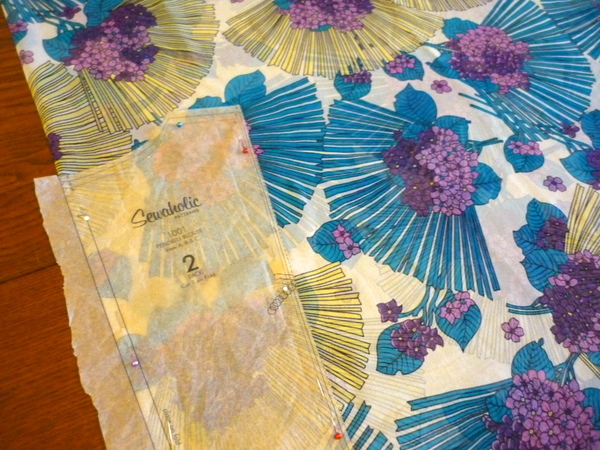
Once all of the pieces have been cut out, remove the pattern tissue from the fabric, as you’ll need most of your pieces to cut the underlining! Clip your notches and mark any markings on the main fabric.
Cutting the underlining:
Next, we’ll cut the underlining. If your pattern pieces got wrinkled, give them a quick press before cutting the underlining. (It doesn’t matter which you cut first, the underlining or the main fabric! Whichever you prefer.)
From the underlining, here are the pieces you have to cut:
- Front, Back, Side Front, Side Back
And here are the optional pieces to cut from underlining, based on our decisions above:
- Neck Binding, Armhole Binding, Ruffles or Sleeves
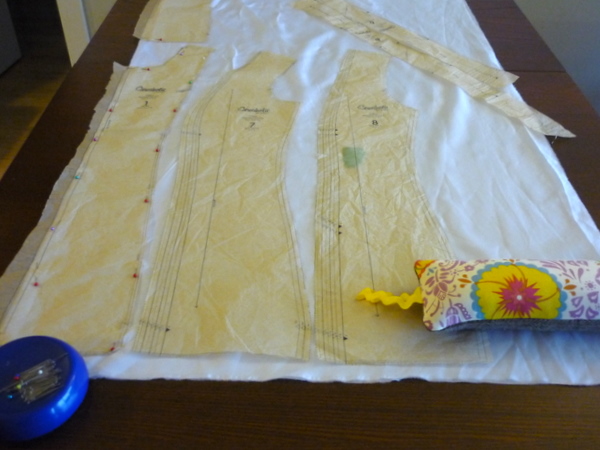
Cut out the pieces, and clip your notches. This will give us reference points for lining up the two layers!
Joining the underlining to the main fabric:
The great part about underlining is that once it’s attached, we can forget about it! After the body pieces are underlined, they’re treated as one layer from that point forward.
Lay the main fabric on top of the underlining fabric, so that the right sides of both fabrics are facing upwards.
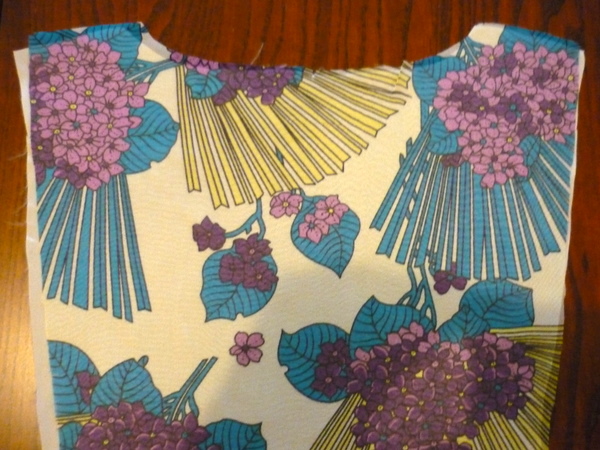 To help line up the pieces, match up the notches and markings, and pin both layers together.
To help line up the pieces, match up the notches and markings, and pin both layers together.
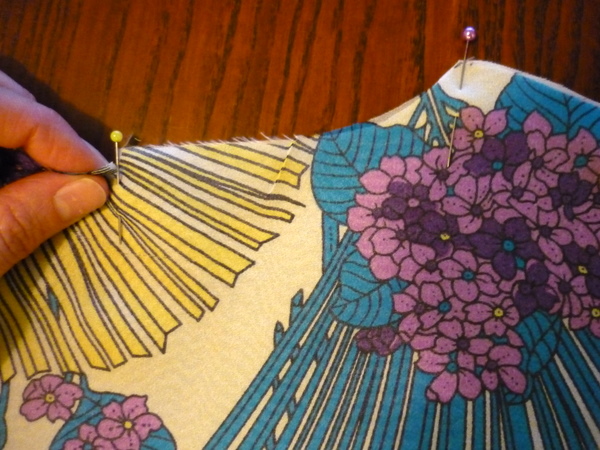
Now, we’re going to baste them together, so we can work with them as one. You can either machine-baste the pieces together, or, you can hand-baste the layers together.
I’ve machine-basted my underlinings on all of my underlined projects, but I’d imagine that hand-basting would be more accurate as your layers won’t slip around and shift under the presser foot. (But hand-basting is much slower than basting by machine.) If you’re still undecided, test both methods on scraps of fabric to pick a method that works best for you!
NOTE: Whatever method of basting you decide on, baste approximately 1/4″ (6mm) from the raw edges. That way, it won’t show on the right side of the garment, and you can leave your basting stitches in the finished blouse.
That’s it for underlining! From now on, when we refer to FRONT – you’ll pick up your underlined front and pretend it’s a single layer of fabric.
Another important note: now that your two layers have become one, you’ll want to use the lowest iron setting when pressing your blouse. For example, I’ve just joined rayon and silk together, so I will use the silk iron setting from now on. If you mixed cotton and polyester, you’ll want to use the polyester setting on the iron.
Any questions? Thoughts on machine-basting versus hand-basting? Other underlining tips and tricks? Comment away!

I’ve found that diagonal/tailor basting the two pieces together works best. That way all areas of the cut piece stay put until your done sewing. All you need to do is make sure you use a very fine needle as to not leave holes in your fabric. The pic below shows what is looks like but it can be done throughout the body of the garment piece and left until the garment is completed
Picture: http://1.bp.blogspot.com/_sGd73gvTrc4/TRILo2oXJ3I/AAAAAAAABqI/YoirmFipb4Q/s320/DSC01718.JPG
Photo credit: http://allmyseams.blogspot.com/
Off-topic, because the image very clearly says Neck Binding: Cut 2—I couldn’t find where the second neck binding goes. Typo or did I miss something?
Also, thought you’d enjoy seeing this vintage pattern with a ruffle sewn into a variation on a princess seam:
http://patternjunkie.typepad.com/pattern_junkie/2011/01/monday-morning-eye-candy-elegant-lounging.html
I love that print you’re using!
Hi Tasia! I love reading your posts, thank you so much. I am wondering if you know of a good tutorial that teaches how to add a lining to a homemade skirt? I am working on a skirt and I’d really like a lining (it’s a bit chilly where I live) in the skirt. Thank you for your help and inspiration and keep up the good work!
I have an unknown 100% silk fabric print. The weave looks like a twill, but its drapey and is a bit thicker than silk charmeuse and also not quite as drapey as the charmeuse.
I’m not sure if I should go with a batiste or some plain silk/poly charmeuse… What are your thoughts?
(I just don’t want my bra to show through is all, since I’ll be wearing it to work.)
Why not sew your fashion fabric and underlining with the right sides together (leaving the hem unsewn) then turn inside out so that you’ve automatically got French’ish seams?
Hi Tasia
Fabulously helpful, as always! I am underlining a polyester chiffon and plan to use a cotton batiste (I think it will feel nicer next to my skin). I didn’t really understand what you said about the binding – did you mean use the main fabric and underlining, or just the underlining by itself?
Thanks!
Pam
I had the same thought as SewSister- would that work? Also, I was wondering two things…
1. I was planning on not doing underlining to my poly chiffon because I wanted to test out the size first, before cutting up more fabric. But then again, The blouse would be more wearable if it had a lining of some kind. How hard would it be to create a lining for the body portion instead, and attach it later, at the neck/armhold binding stage?
2. Can you go over ways to keep our machines from ‘eating’ these fabrics? I’ve never used tear away stabilizer before, and I don’t totally understand what to do.
Pam – I think Tasia means just the underlining fabric in her case. Just received my Pendrell pattern in the post and looking forward to choosing a fabric!
Is there a flickr group for this sew along? I’m dying to see everyone’s fabric/progress!
I am drooling over that silk print!
It is going to make a gorgeous blouse.
One of the features I most appreciate about my sewing machine is the adjustable presser foot pressure. Using one of the less-pressure settings really helps keep the top fabric from shifting around while basting or sewing. I also reduce the pressure when I need to sew over a thick seam.
A similar discussion cropped over at Gertie’s blog recently. The faux-Hong Kong finish has been referred to as “flat-lining.” This underlining technique is done to vertical seams only. This link will take you to Pattern Review for an explanation. Threads Magazine also had this technique recently, but I haven’t found it yet. Interesting concept.
http://sewing.patternreview.com/cgi-bin/review/readreview.pl?readreview=1&ID=1044
@Liz: I’m no fabric expert at all, but could it be silk ottoman? I saw some beautiful drape-y silk fabric in the store the other day and it was labelled ottoman, not sure exactly what that means but it was heavier and had a visible weave like a twill.
Daiyami – I noticed that too – fyi, I’m finished with my blouse and I just used 1 for neck binding. It worked very well so I think this may be a typo. (Tasia: could you comment on that? Thanks, K)
Hi Everyone! I’m going to follow up with a post later on basting underlining – I tried a few things today that might be helpful to see, as examples.
@K-Line: , @daiyami: You guys are correct! The neck binding only needs to be ‘Cut 1’ – it’s a minor typo. It doesn’t change the fabric requirements or the cutting layouts, so we’re not wasting any fabric. Sorry about the confusion there :)
@nikole: Thanks so much for this! This is really helpful. I’ve tested the diagonal basting on my pieces today and it worked really well, I’ll post photos for everyone to see shortly.
@daiyami: I do love that detailing, and that pattern! Perhaps a bit dramatic for my real life, but awesome for my imaginary one :)
@Kathleen: Hi Kathleen! I don’t know of a tutorial offhand, but I’ll see what I can dig up for you…
Try this one:
http://sewing.patternreview.com/SewingDiscussions/topic/36662
or this one:
http://www.threadsmagazine.com/item/4971/a-shortcut-to-great-linings
Hope that helps!
@Liz: Ok – if you use batiste, it sounds like it won’t change the hand of your fabric too much, as it’s already a little more firm than charmeuse. Batiste would be the easiest to work with, of your options. If you use poly charmeuse, you’ll have polyester next to your skin instead of silk, which would be hotter and doesn’t breathe as well. If it were me? I’d probably use the batiste as a first choice, silk charmeuse as a second choice, and poly charmeuse as a last choice, if I couldn’t find any of the first two. Cost-wise, cotton batiste is less expensive than silk charmeuse, too. I hope that helps!
@SewSister: You could do that, for sure! I would be hesitant to do that with my demo fabric, only because I have two slippery fabrics and I have a feeling they’d shift all over the place. I’d try that method if my fabrics were more stable – like cotton lawn and batiste? I feel like that would give the best results. Also, it might be a bit finicky over the curved seams. Especially if you’ve done a Full Bust adjustment! It’s definitely a method I want to try in the future though…
@Pam: Hi Pam! Sorry if it was confusing. I meant to say, you can cut the binding pieces out of either fabric. (But not both.) For yours, I’d probably suggest binding with the batiste underlining fabric. I’m using just the underlining for mine, as I feel like it will be more stable than the chiffon.
@Bhoomika: Adding a lining later on… in theory, it could work! The things I would worry about would be the seam allowances showing through, and how the lining would hang inside the blouse. If it’s at all off at the neckline or armholes, it may bind or twist while you wear it and not feel very good! Also, if you make the blouse and finish the seam allowances, and THEN make a lining with seam allowances too, the edges might show through your sheer fabric and not look very nice. It might work, and solve the sheerness problem, but you might not be happy with the results! Of course, you could always wear a camisole underneath the finished blouse. And who knows, you might love the way the lining works out! It’s hard for me to picture especially since I’m a fan of underlining, and how the seam allowances are hidden..
@Sewingdina: Thanks for jumping in here – you’re exactly right!
@Cat: Yes! here’s a link to the Flickr group:
http://www.flickr.com/groups/sewaholicpatterns/
@Venus de Hilo: Great point about the adjustable foot pressure. I don’t think mine has that option, but now I’m curious. It’s a good reminder to re-read our manuals every now and then just to see what they’re capable of!
@Corinne: Thanks for the link! I’m curious to try this method on something one day. Something where the fit is already perfect of course, these would be a pain to unpick!
Thanks for all the comments today! More on underlining, coming soon :)
So, do you do both a lining and underlining?
@Andrea: Oh, I’d just do one or the other. That would be a lot of layers – which in some garments, might be OK, but in a simple blouse that’s a lot of potential bunching! I much prefer underlining myself, that would be my recommendation! Hope that helps :)
Hi, Loved this article. Is it possible to put a lining in a sheer blouse that I purchased from a store? It has a high-low hem. Thank you.